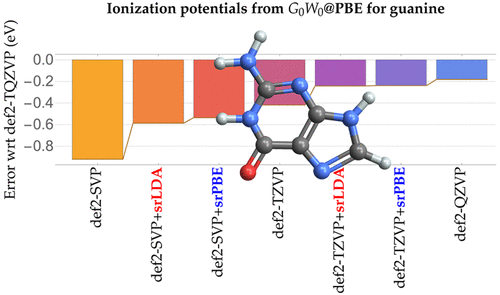当前位置:
X-MOL 学术
›
J. Chem. Theory Comput.
›
论文详情
Our official English website, www.x-mol.net, welcomes your feedback! (Note: you will need to create a separate account there.)
Density-Based Basis-Set Incompleteness Correction for GW Methods.
Journal of Chemical Theory and Computation ( IF 5.5 ) Pub Date : 2020-01-13 , DOI: 10.1021/acs.jctc.9b01067 Pierre-François Loos 1 , Barthélémy Pradines 2, 3 , Anthony Scemama 1 , Emmanuel Giner 2 , Julien Toulouse 2, 4
Journal of Chemical Theory and Computation ( IF 5.5 ) Pub Date : 2020-01-13 , DOI: 10.1021/acs.jctc.9b01067 Pierre-François Loos 1 , Barthélémy Pradines 2, 3 , Anthony Scemama 1 , Emmanuel Giner 2 , Julien Toulouse 2, 4
Affiliation

|
Similar to other electron correlation methods, many-body perturbation theory methods based on Green's functions, such as the so-called GW approximation, suffer from the usual slow convergence of energetic properties with respect to the size of the one-electron basis set. This displeasing feature is due to the lack of explicit electron-electron terms modeling the infamous Kato electron-electron cusp and the correlation Coulomb hole around it. Here, we propose a computationally efficient density-based basis-set correction based on short-range correlation density functionals which significantly speeds up the convergence of energetics toward the complete basis set limit. The performance of this density-based correction is illustrated by computing the ionization potentials of the 20 smallest atoms and molecules of the GW100 test set at the perturbative GW (or G0W0) level using increasingly large basis sets. We also compute the ionization potentials of the five canonical nucleobases (adenine, cytosine, thymine, guanine, and uracil) and show that, here again, a significant improvement is obtained.
中文翻译:

GW方法的基于密度的基础集不完整校正。
与其他电子相关方法类似,基于格林函数的多体摄动理论方法(例如所谓的GW近似)相对于单电子基集的大小,通常会遇到能量特性缓慢收敛的问题。这种令人不快的特征是由于缺乏对臭名昭著的加藤电子-电子尖峰及其周围的相关库仑孔进行建模的明确的电子-电子术语。在这里,我们提出了一种基于计算效率的基于密度的基集校正方法,该校正方法基于短程相关密度函数,可显着加快能量学向完整基集极限的收敛速度。通过使用越来越大的基集计算微扰GW(或G0W0)级别的GW100测试集的20个最小原子和分子的电离势,可以说明这种基于密度的校正的性能。我们还计算了五个规范核碱基(腺嘌呤,胞嘧啶,胸腺嘧啶,鸟嘌呤和尿嘧啶)的电离势,并表明在此再次获得了显着改善。
更新日期:2020-01-14
中文翻译:

GW方法的基于密度的基础集不完整校正。
与其他电子相关方法类似,基于格林函数的多体摄动理论方法(例如所谓的GW近似)相对于单电子基集的大小,通常会遇到能量特性缓慢收敛的问题。这种令人不快的特征是由于缺乏对臭名昭著的加藤电子-电子尖峰及其周围的相关库仑孔进行建模的明确的电子-电子术语。在这里,我们提出了一种基于计算效率的基于密度的基集校正方法,该校正方法基于短程相关密度函数,可显着加快能量学向完整基集极限的收敛速度。通过使用越来越大的基集计算微扰GW(或G0W0)级别的GW100测试集的20个最小原子和分子的电离势,可以说明这种基于密度的校正的性能。我们还计算了五个规范核碱基(腺嘌呤,胞嘧啶,胸腺嘧啶,鸟嘌呤和尿嘧啶)的电离势,并表明在此再次获得了显着改善。


























 京公网安备 11010802027423号
京公网安备 11010802027423号